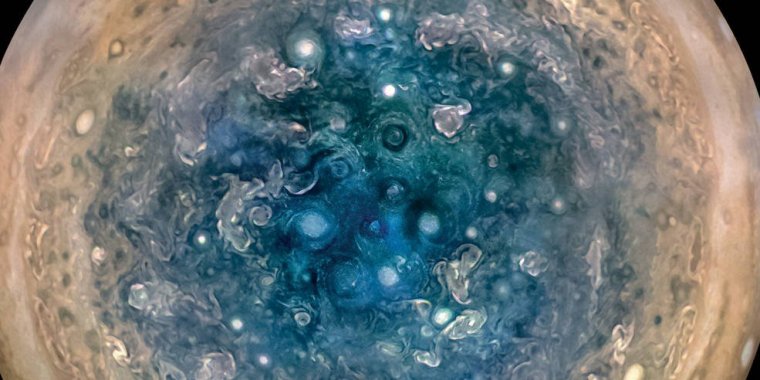| News / Space News |
First Science Results from NASA’s Juno Mission
Early science results from NASA’s Juno mission to Jupiter portray the largest planet in our solar system as a complex, gigantic, turbulent world, with Earth-sized polar cyclones, plunging storm systems that travel deep into the heart of the gas giant, and a mammoth, lumpy magnetic field that may indicate it was generated closer to the planet’s surface than previously thought.

This image shows Jupiter’s south pole. The oval features are cyclones, up to 600 miles (1,000 kilometers) in diameter. ![]()
Among the findings that challenge assumptions are those provided by Juno’s imager, JunoCam. The images show both of Jupiter's poles are covered in Earth-sized swirling storms that are densely clustered and rubbing together.
Another surprise comes from Juno’s Microwave Radiometer (MWR), which samples the thermal microwave radiation from Jupiter’s atmosphere, from the top of the ammonia clouds to deep within its atmosphere.
The MWR data indicates that Jupiter’s iconic belts and zones are mysterious, with the belt near the equator penetrating all the way down, while the belts and zones at other latitudes seem to evolve to other structures.
The data suggest the ammonia is quite variable and continues to increase as far down as we can see with MWR, which is a few hundred miles or kilometers.
Prior to the Juno mission, it was known that Jupiter had the most intense magnetic field in the solar system. Measurements of the massive planet’s magnetosphere, from Juno’s magnetometer investigation (MAG), indicate that Jupiter’s magnetic field is even stronger than models expected, and more irregular in shape.
MAG data indicates the magnetic field greatly exceeded expectations at 7.766 Gauss, about 10 times stronger than the strongest magnetic field found on Earth.
Juno also is designed to study the polar magnetosphere and the origin of Jupiter's powerful auroras—its northern and southern lights. These auroral emissions are caused by particles that pick up energy, slamming into atmospheric molecules. Juno’s initial observations indicate that the process seems to work differently at Jupiter than at Earth. (NASA)
YOU MAY ALSO LIKE



